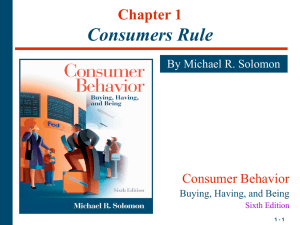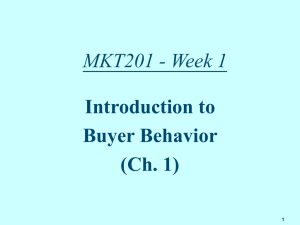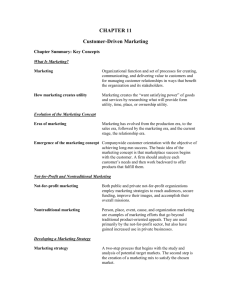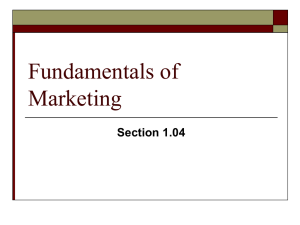chapter 12
advertisement
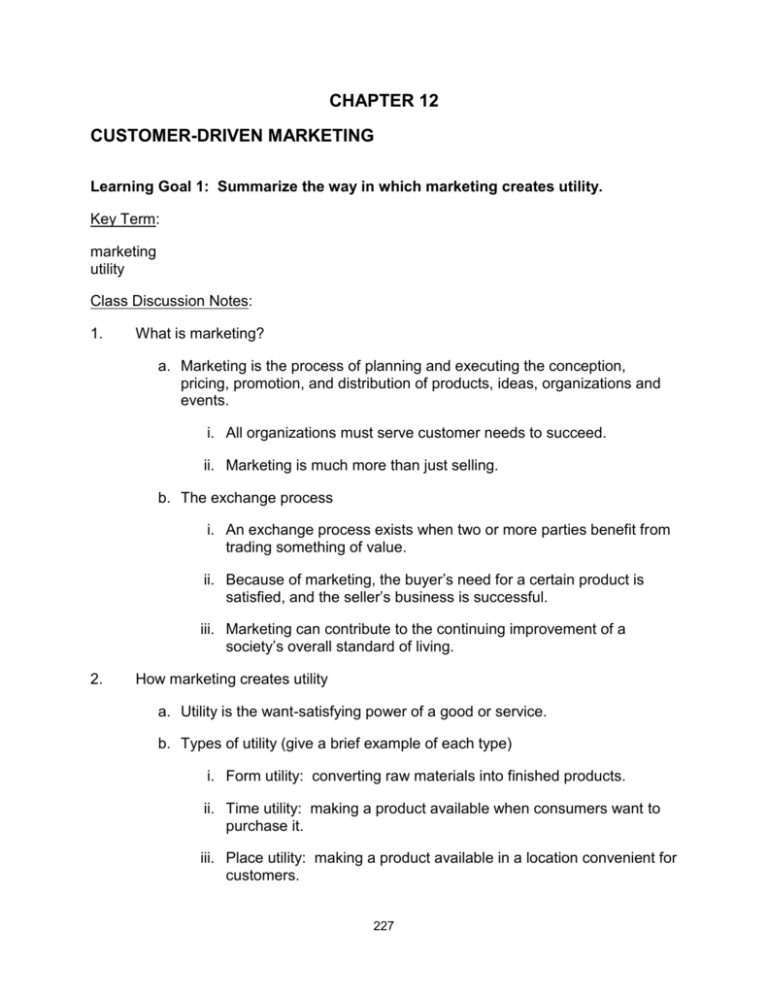
CHAPTER 12 CUSTOMER-DRIVEN MARKETING Learning Goal 1: Summarize the way in which marketing creates utility. Key Term: marketing utility Class Discussion Notes: 1. What is marketing? a. Marketing is the process of planning and executing the conception, pricing, promotion, and distribution of products, ideas, organizations and events. i. All organizations must serve customer needs to succeed. ii. Marketing is much more than just selling. b. The exchange process i. An exchange process exists when two or more parties benefit from trading something of value. ii. Because of marketing, the buyer’s need for a certain product is satisfied, and the seller’s business is successful. iii. Marketing can contribute to the continuing improvement of a society’s overall standard of living. 2. How marketing creates utility a. Utility is the want-satisfying power of a good or service. b. Types of utility (give a brief example of each type) i. Form utility: converting raw materials into finished products. ii. Time utility: making a product available when consumers want to purchase it. iii. Place utility: making a product available in a location convenient for customers. 227 Chapter 12 Customer-Driven Marketing iv. Ownership utility: refers to the orderly transfer of products from the seller to the buyer. c. Production creates form utility: time, place, and ownership utility are created by the marketing function. Learning Goal 2: Explain the marketing concept and relate how customer satisfaction contributes to added value. Key Terms: marketing concept customer satisfaction Class Discussion Notes: 1. Four eras in the history of marketing (Figure 12.2) a. Production era: A good product will sell itself. b. Sales era: Creative advertising and selling will overcome customer resistance and convince them to buy. c. Marketing era: The customer is king; find a need and fill it. d. Relationship era: Long-term relationships lead to success. 2. Emergence of the marketing concept a. A companywide consumer orientation to promote long-run success. b. Marketplace success begins with the customer. c. The emergence of the marketing concept is explained by the shift from a seller’s market to a buyer’s market. 3. Delivering added value through customer satisfaction and quality a. Customer satisfaction is the result of a product (good or service) meeting or exceeding the buyer’s needs and expectations. b. Customers today want more than just products; they also want value. i. Value is their perception that the quality of a product is in balance with the price charged. ii. A value-added product is one that exceeds value expectations. 228 Part 4 Marketing Management iii. Customers who believe that they have received value are more likely to remain satisfied with the company and continue their relationships. c. Quality—the degree of excellence or superiority of an organization’s products—is another way firms enhance customer satisfaction. i. A reputation for quality can enhance a firm’s competitiveness; a slip in quality can damage a firm’s image. ii. Although quality relates to physical product traits—such as durability—it also includes customer service. 4. Customer satisfaction and feedback a. Successful companies make every attempt to ensure the satisfaction of their customers. b. One of the best ways to find out whether or not customers are satisfied is to obtain customer feedback. i. Customer complaints are excellent sources of customer feedback. ii. Many customers often feel greater loyalty after a conflict has been resolved than if they had never complained at all. 5. Expanding marketing’s traditional boundaries a. Not-for-profit marketing i. Marketing strategies are important for not-for-profit organizations because they are competing for dollars just as commercial businesses are. ii. Not-for-profit organizations operate in both the public and private sectors (you may want to give an example of each). iii. In some cases, not-for-profit organizations form a partnership with a profit-seeking company to promote the firm’s mission or distribute its products. b. Nontraditional marketing i. Person marketing: Efforts designed to attract the attention, interest, and preference of a target market toward a person. ii. Place marketing: Efforts designed to attract people to a particular area. 229 Chapter 12 Customer-Driven Marketing iii. Event marketing: Efforts designed to promote events such as athletic competitions and cultural and charitable performances. iv. Cause marketing: Efforts designed to promote social causes. v. Organization marketing: Efforts designed to influence consumers to accept the goals of, receive the services of, or contribute in some other way to an organization. 6. Answers to concept check questions (p. 392) a. Question 1: Marketing strategies are important for not-for-profit organizations because they are competing for dollars just as commercial businesses are. b. Question 2: Political candidates usually engage in person marketing; efforts designed to attract the attention, interest, and preference of a target market toward a person. Learning Goal 3: Describe the components of a market and distinguish between B2B and B2C marketing. Learning Goal 4: Outline the basic steps in developing a marketing strategy. Key Terms: target market marketing mix Class Discussion Notes: 1. Developing a marketing strategy a. Study and analyze potential target markets, and choose between them b. Create a marketing mix to satisfy the chosen market (or markets). c. Figure 12.7 illustrates the relationship among the target market, the marketing mix variables, and the marketing environment. 2. What is a market? a. A firm’s marketers find a need through careful and continuing study of the individuals and business decision makers in its potential market. b. A market consists of people with purchasing power, willingness to buy, and authority to make purchase decisions. c. Types of markets (classified by type of product) 230 Part 4 Marketing Management i. Consumer products (B2C). ii. Business products (B2B) d. A target market i. The group of people toward who an organization markets its products or ideas with a strategy designed to satisfy their specific needs and preferences. ii. Customer needs and wants vary considerably, and no single organization has the resources to satisfy everyone. 3. Developing a marketing mix (consists of a blending of four variables) a. Product strategy: designing a product with needed attributes, package design, brand names, trademarks, warranties, product images, new product development, and customer service. b. Distribution strategy: ensures that customers receive their purchases in the proper quantities at the right times and locations. c. Promotional strategy: an effective blend of advertising, personal selling, sales promotion, and public relations. d. Pricing strategy: setting justifiable and profitable prices for a firm’s products (one of the most difficult areas of marketing decision making) 4. Developing a marketing mix for international markets a. General options i. Standardization: offering the same marketing mix for every market. ii. Adaptation: developing a unique mix to fit each market. b. Advantages of standardization i. Lower costs and reliable marketing performance. ii. Works best with business goods such as steel, chemicals, and aircraft where sensitivity to a nation’s culture isn’t required. c. Advantages of adaptation i. Lets marketers vary their marketing mix to suit local competitive conditions, consumer preferences, and government regulation. ii. Consumer preferences often depend on a nation’s culture. 231 Chapter 12 Customer-Driven Marketing iii. Consumer products tend to be more culture dependent than business products. d. Increasingly, marketers are trying to build adaptability into the designs of standardized products for international and domestic markets. Learning Goal 5: Describe the marketing research function. Key Terms: marketing research data mining Class Discussion Notes: 1. What is marketing research? a. Marketing research is the collection and use of information to support marketing decision making. b. Reasons for conducting research: i. Identify marketing problems and opportunities. ii. Analyze competitors’ strategies. iii. Evaluate and predict consumer behavior. iv. Gauge the performance of existing products and package designs and assess the potential of new ones. v. Develop price, promotion, and distribution plans. 2. Obtaining marketing research data a. Internal data i. Generated within the organization. ii. Includes financial records such as unpaid bills, inventory levels, and sales (by territories, customers, or product lines). b. External data i. From sources outside the firm. ii. Includes previously published data. c. Secondary data 232 Part 4 Marketing Management i. Data previously collected from a variety of sources. ii. Low cost and easily accessible. iii. May not offer sufficient insight into some marketing problems (data could be too old or in the wrong form). d. Primary data i. Data collected for the first time through observation or surveys. ii. Observation may be sufficient to provide insight into some marketing problems. iii. When marketers need information about attitudes, opinions, or motives they must conduct surveys or use focus groups. e. There is a positive correlation between the accuracy of the information collected and the effectiveness of the resulting marketing strategies. 3. Computer-based marketing research systems a. Computer technology helps many businesses create a strategic advantage in collecting and analyzing research data. b. Marketing research firms—such as AC Nielsen—store consumer data in commercially available databases. c. “Business intelligence” software crunches enormous amounts of data looking for trends, problems, and new opportunities for companies. 4. Data mining a. A computer search of massive amounts of customer data to detect patterns and relationships. b. Data warehouses are sophisticated customer databases that allow managers to combine data from several different organizational functions. c. By identifying patterns and connections, marketers can increase the accuracy of their predictions about the effectiveness of their strategy options. 233 Chapter 12 Customer-Driven Marketing Learning Goal 6: Identify each of the methods available for segmenting consumer and business markets. Key Term: market segmentation Class Discussion Notes: 1. What is market segmentation? a. The process of dividing a total market into several relatively homogeneous groups. b. Market segmentation attempts to isolate the traits that distinguish a certain group of customers from the overall market. i. Segmentation does not always promote marketing success. ii. Several criteria marketers should consider during when segmenting a market are listed in Table 12.2. iii. The effectiveness of a segmentation strategy depends on how well the market meets these criteria. iv. Once marketers identify a market segment to target, they can create an appropriate marketing strategy. 2. How market segmentation works a. Will the firm be offering products to consumers (B2C market) or to producers who will use them directly or indirectly in providing others products for resale (B2B market). b. Common bases for segmenting consumer markets: i. Geographic. ii. Demographic. iii. Psychographic. iv. Product-related. c. Common bases for segmenting business markets: i. Customer-based. ii. End-use. 234 Part 4 Marketing Management iii. Geographical. 3. Segmenting consumer markets a. Geographic segmentation i. The oldest form of method of segmentation. ii. Divides a market into homogeneous groups on the basis of population locations. iii. This approach is useful when consumer preferences and purchase patterns for a product differ between regions. (The text gives several examples. You may wish to ask students for other examples.) iv. Businesses consider a wide variety of variables including population, whether the market is urban, suburban, or rural, job growth, and migration patterns. b. Demographic segmentation i. The most common method of market segmentation. ii. Distinguishes markets on the basis of various demographic or socioeconomic characteristics. iii. Common measures include income, age, occupation, household size, stage in the family life cycle, education, ethnic group, and gender. iv. The U.S. Census Bureau is an excellent source of demographic information for the domestic market (a secondary source of data). v. Gender has traditionally been a simple way to define markets for certain products. vi. Age is perhaps the most volatile factor in demographic segmentation with the aging of the population. vii. Minority groups hold a combined purchasing power in excess of $1 trillion—marketers cannot overlook these groups. c. Psychographic segmentation i. Divides consumer markets into groups with similar psychological characteristics, values, and lifestyles. 235 Chapter 12 Customer-Driven Marketing ii. A lifestyle is the sum of a person’s needs, preferences, motives, attitudes, social habits, and cultural background. iii. Psychographic studies have evaluated motivations for purchases of hundreds of products. iv. Although demographic classifications are relatively easy to identify, researchers need to define psychographic categories. (The text uses an example of how researchers were able to classify women by their life stages—not necessarily their ages—by identifying common attitudes, desires, values, and lifestyles.) d. Product-related segmentation i. Segmentation based on buyers’ relationships to the product. ii. The three most popular approaches are based on benefits sought, usage rates, and brand loyalty levels. 4. Segmenting business markets a. Geographic segmentation i. Resembles those for consumer markets. ii. Many B2B marketers target geographically concentrated industries. b. Customer-based segmentation i. Begins with a product intended to suit a specific organizational unit. ii. Another way to group firms by their demographics is to segment them by size based on sales revenues or number of employees. c. End-use segmentation i. Focuses on the precise way a B2B purchasers will use a product. ii. Similar to the benefits-sough segmentation for consumer markets. Learning Goal 7: Distinguish between buyer behavior and consumer behavior. Key Terms: buyer behavior consumer behavior Class Discussion Notes: 236 Part 4 Marketing Management 1. Determining what customers want a. Buyer behavior is a series of decision processes by individual consumers who buy products for their own use and organizational buyers who purchase business products to be used directly or indirectly in the sale of other items. b. Consumer behavior consists of the actions of ultimate consumers directly involved in obtaining, consuming, and disposing of products and the decision processes that precede and follow these actions. 2. Determinants of consumer behavior and business buying behavior a. By studying people’s purchasing behavior, marketers can identify consumers’ attitudes toward and uses of their products. b. Both personal and interpersonal factors influence the behavior of an ultimate consumer. i. Personal influences include individual needs and motives, perceptions, attitudes, learned experiences, and their self-concepts. ii. Interpersonal determinants of consumer behavior include cultural, social, and family influences. c. External events can also influence consumer behavior (an example is the recent SARS epidemic). d. Business buying behavior is affected by a variety of organizational influences in addition to the preferences of the business buyers themselves. 3. Steps in the consumer behavior process a. Consumer decision making follows the sequential process (outlined in Figure 12.12) with interpersonal and personal influences affecting every step. b. The individual steps in the consumer behavior process i. Recognition of problem or opportunity. ii. Search for alternatives. iii. Evaluation of alternatives. iv. Purchase decision. v. Purchase act. 237 Chapter 12 Customer-Driven Marketing vi. Post purchase evaluation and feedback. Learning Goal 8: Discuss the benefits of relationship marketing. Key Term: relationship marketing Class Discussion Notes: 1. Transaction to relationship marketing a. Transaction marketing i. Characterized by buyer and seller exchanges with limited communication and no ongoing relationships between the parties. ii. Goal was to negotiate hard with suppliers to secure the least expensive raw materials; then build products and find customers to buy them at prices high enough to cover costs and still earn a profit. b. Relationship marketing i. Developing and maintaining long-term, cost-effective exchange relationships with individual customers, suppliers, employees, and other parties for mutual benefit. ii. A result of today’s hyper-competitive business environment. iii. As its ultimate goal, relationship marketing seeks to achieve customer satisfaction. c. Managing relationships, rather than transactions, often leads to creative partnerships. (The text reviews a few of the ways actual businesses are using relationships to reach corporate goals.) 2. Benefits of relationship marketing a. Businesses that forge solid links with suppliers and customers are often rewarded with lower costs and higher profits. b. Long-term agreements with a few high-quality suppliers frequently reduce a firm’s production costs. c. By identifying current purchasers—and maintaining good relationships with them—organizations can efficiently target their best customers. d. Attracting a new customer costs as much as five times more than keeping a current one.. 238 Part 4 Marketing Management e. Purchasers who repeatedly buy from one business may find that they save time and gain service quality as the business learns their specific needs. 3. Tools for nurturing customer relationships a. Most relationship-oriented businesses quickly discover that not all customers justify equal treatment. i. Some customers generate more profitable business than others. ii. While businesses shouldn’t ignore any customer, their objectives and tactics for managing relationships with individual customers often reflect the overall value to the firm of the resulting business. b. Frequency marketing and affinity marketing programs i. Frequency marketing programs reward purchasers with cash, rebates, merchandise, or other premiums. ii. An affinity program is a marketing effort sponsored by an organization and solicits involvement by individuals who share common interests or activities. c. One-on-one marketing i. The ability to customize product offerings to individual needs and rapidly deliver products. ii. Has become increasingly dependent on technological investments. iii. The Internet and computer databases provide strong support for one-on-one marketing. 239


